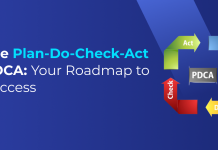
The central purpose of the Lean methodology is to expand the effectiveness and performance of various processes in the company by decreasing waste like long wait times, errors, and bottlenecks in material and information flow. One tool that can be used to rectify waste is ‘Value Stream Mapping’.
Value stream mapping gives a visual image of the flow of materials and information during the process. It helps to recognize, describe, reduce waste, and ultimately create effective flow in all the processes in the organization.
Value stream mapping organizes all the value-added as well as non-value-added services needed to make the assets. It consists of the process flows originating from the raw materials to obtain the product to deploying it in the hands of the consumers.
In this article, we will discuss all relevant details about the Value Stream Mapping tool for effective usage and application in any organization.
What Does Value Stream Mapping Do?
Value stream mapping is applied to:
- Graphically represent the flows of materials and information in a process. It presents the interplay among multiple organizational functions- both manufacturing as well as operational services.
- Pinpoint the difficulty fields, wastefulness, errors, and bottlenecks more efficiently as it blends and maps the information flows, and material flows along with the order of tasks. It also shows the cycle times and lag times in different tasks.
- Includes all the stakeholders in each step of the process, and hence, it fits easily to develop and execute countermeasures to promote cultural diversity in the organization. It gives a proper performance of all the limiting factors.
- Continuous development is supported since the area can be sharpened on lean transformation teams, front-line supervision, and upper management.
How to Create and Manage a Value Stream Map
Step 1: Following the Current State
The very initial action is to pick the product or product family, settle on the purpose of change and lead the team for value stream mapping. A cross-functional team should be chosen and include all the stakeholders involved in the method. Once the unit is picked, the physical way of the material flow should be driven through. Everything including both primary and secondary flow needed for the manufacturing method must be mapped. While training through all the material flow ways, recognize and document all the information points nicely. This will serve to make the current state value stream map. Mentioned below are some key points to keep in mind while creating the map.
- Know the Origin and Endpoints of Your Process
In the end, your process master or project sponsor has the ultimate control over when a process starts and ends but in a value stream report this is typically from the time a consumer requests to the moment when they acquire the product. Reasons could be made for taking the whole process by adding things like trade settlement; funds opening an account, restocking or retooling taking place, all “technical debt” being created, etc.
- Describe the Process Stream
Map your method, including sub-steps. It’s essential to track the flow of one unit (goods or services) running through the process. Note fields that need inputs or outputs. Does that change your design? Did you miss a step? Be sure to share those communications with relevant teams.
- Add Metrics for Every Process Run
What steps you take depends on what kind of project you are doing. What can you provide to cover? Some processes are more difficult or more costly to measure than others. Even with extensive resources, the spread and center of your process order might influence the measures you want – perhaps an aggregate is OK in a typical distribution case. Still, in another, you may want to measure the center.
- Determine the Bounds
What are the bounds of the case? The lower bound, or fastest time may be the ‘happy way.’ The top-bound, or latest time, might be the worst-case situation. Here’s how you can determine the bounds:
- What is the standard time – or most possible time?
- What is central time?
- Is there any changeover or prep time needed?
- What’s the uptime?
- What devices are used in this step?
- Human resources – how many people, how many shifts.
- What are the machine’s capabilities?
- What is the throughput of this step? How many are delivered?
- How much inventory stacks up?
Step 2: Analyze And Reflect
At this level, analyze the current status of the value stream map with all the stakeholders in order to relinquish adjustments on the current performance of the process. Next, the limiting circumstances, needs, defects and bottlenecks should be recognized in the ongoing process. The production and cost of each limiting factor should be quantified. It is also essential to identify the source causes and not the signs of the limitations of the current state value stream map. Based on the source causes of the defects, cost-effective answers should be received. Ultimately, the current state value stream map should be tailored to match the proposed solutions and changes in reducing the limitations of the process. The updated value stream map is now termed the ‘future state value stream map’.
Look at the value being delivered and waste caught by:
- Recording unspecified wastes including, but not restricted to, wait time, revise time, retooling, and downtime.
- Noting any process steps that are irrelevant or not valuable.
How to determine if a step is valuable or not?
- Call out the value-added projects.
- Is it prepared right the first time, every time?
- Is the customer ready to pay for it?
- Has the process object physically altered?
Step 3: Improve
The next step is to identify ways to improve the process. How can you cut out, eliminate, or withdraw those wastes that were identified? What are the bottlenecks in the method? Which step in the process stream has the heaviest throughput or cycle time? Is there a process to make that more effective?
Before completing the future state value stream map, discuss and gain consent from all the stakeholders concerned. Then, the changes need to be performed, and in that process, the affected systems, bills of materials, and training materials should be changed. Training should be given to the staff based on new procedures and conditions. Ultimately, the implementation of the changes must be promoted on a descending priority base.
The point isn’t to produce a high score for any particular process step but to instead get a service full or produce a product for a client quicker utilizing fewer resources while maintaining excellent quality.
Step 4: Sustain
The performed changes should be checked and validated through setting and measuring performance and cost-related parameters using useful essential performance notices. The new standard systems should be controlled and reinforced continuously.
It goes without saying that the value stream mapping tool can be highly beneficial to increase productivity and efficiency in any organization. However, the tool is only effective if implemented and used properly. For individuals to gain a proper understanding of Value Stream Mapping, then they have to take part in a formal training program in some of the popular quality management training courses from an accredited training partner. With improved knowledge and new skills gained, professionals will be able to deliver value by eliminating waste.
Some of the popular quality management training courses that individuals and enterprise teams can take up are:
Lean Six Sigma Green Belt Online Course














